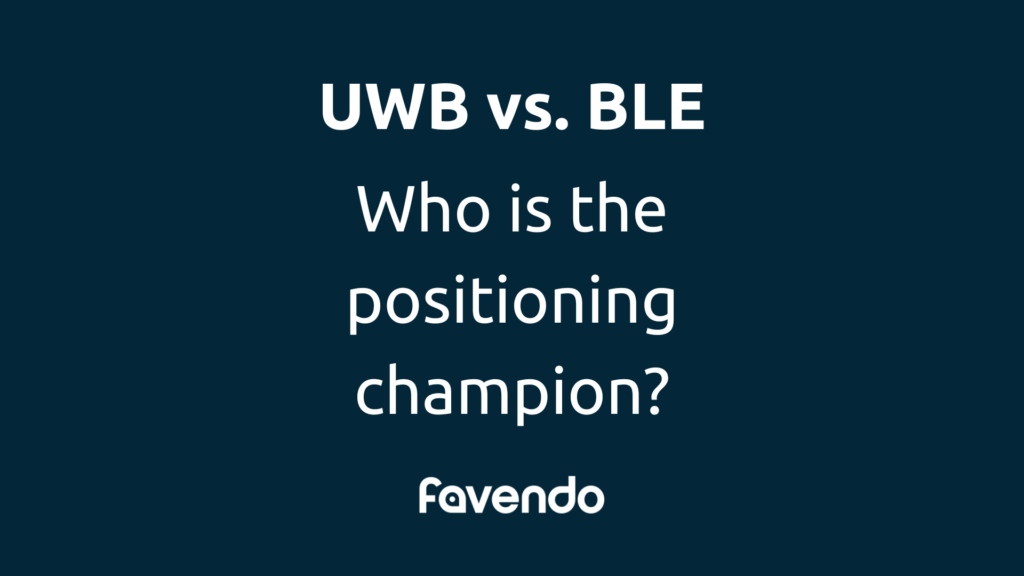12.12.2022
UWB vs. BLE: A technology comparison for indoor positioning

BLE or UWB – which technology is better for indoor positioning? We try to clarify. Because when it comes to indoor positioning, there are various technologies and a number of combinations available. But especially in the context of Industry 4.0, the question often pops up as to which technology is better for asset tracking or localization in general – BLE or UWB.
Bluetooth Low Energy and Ultra Wideband are both so-called short-range technologies that can be used to determine the positions of assets and people. So what are the differences?
How UWB works
UWB is a low-power radio technology for transmitting data in the range from 3.1 to 10.6 GHz. This broad frequency spectrum offers the advantage of not being tied to any frequency, and unused frequency capacity can be ideally utilized. Sensors attached to objects or people send a wideband signal at a specific interval to various fixed anchor points nearby, which then transmit this data to a positioning engine.
Most commonly, UWB technology is used to position objects and people using Time Difference of Arrival (TDoA). This method of position calculation has a particularly low energy consumption. Here, the positioning engine calculates the time differences of arrival to each anchor point to determine the location of the sensor with an accuracy of up to 10 cm. TDoA calculations typically require a sensor to communicate with at least 4 anchors within the line-of-sight. However, distances of up to 250 m can be achieved with a line-of-sight.
How BLE works
Bluetooth Low Energy is also a radio frequency technology. In contrast to UWB, BLE uses transmission in the 2.4 GHz band on 80 different 1 MHz channels between 2400 and 2483.5 MHz.
In BLE tracking, sensors attached to moving objects or people communicate with trackers, i.e. permanently mounted anchor points, in the environment. If a tagged asset is within range of trackers, the positioning engine uses the signal strength (RSSI value) to calculate the object’s location. An accuracy of 3 – 5 m can be achieved. The tracker infrastructure has a great influence on the accuracy of the location data. The more precise and tightly meshed the trackers are positioned, the more accurate the localization of the assets.
By using BLE AoA (Angle of Arrival), the accuracy can also be improved to less than 1 meter. Whether localization via BLE RSSI or BLE AoA makes sense depends on the respective use case and its requirements.
The comparison
| BLE RSSI | BLE AoA | UWB | |
|---|---|---|---|
| Accuracy | 3m | 0,1 to 0,5 m | Under optimal conditions: 0.1 to 0.3 m – 3D localization possible |
| Connectivity | No line of sight necessary | Line of sight to at least 3 anchors required | Line of sight to at least 4 anchors required |
| Costs | Hardware implementation costs significantly lower compared BLE AoA or UWB; Hardly any maintenance costs |
Slightly higher hardware costs compared to BLE RSSI | Slightly higher hardware and implementation costs compared to BLE RSSI & AoA |
| Power Consumption | very low | low | medium |
| Scalability | high | high | difficult |
Bluetooth or UWB – the bottom line
So, who is the positioning champion? There is no clear answer to this question. After all, there is not the one positioning use case. Both technologies have their advantages and can score points in various use cases with reliable positioning data.
If you need high-precision three-dimensional asset tracking, you have to resort to UWB and bite the bullet of high costs. However, it is also important to remember that the accuracy of 10 centimeters or better proclaimed for UWB can actually only be achieved under laboratory conditions. Depending on the use case, UWB delivers an accuracy of 0.5 to 1m under reasonable circumstances.
For “simpler” tracking solutions that can be easily scaled up for this purpose, the less expensive BLE is the technology of choice. Using the AoA positioning method (Angle of Arrival), positioning accuracy in the sub-meter range can also be achieved via Bluetooth. Although the costs increase with the precision, AoA remains significantly below the investment size of a UWB solution.